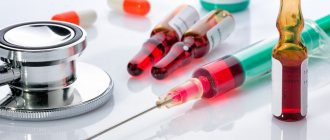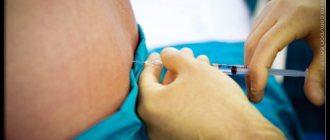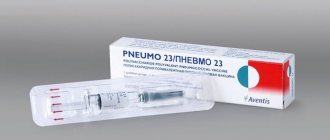Please check with the clinic administrators for availability of vaccines.
Tetanus is a severe acute infectious disease caused by the bacterium Clostridium, primarily affecting the nervous system. Human infection occurs when clostridia penetrate through damaged skin or mucous membranes (wounds, abrasions, cuts, burns with skin damage).
Spores of the causative agent of tetanus can persist for a long time in soil and water. As the disease develops, the most striking symptom is increasing muscle spasms of the limbs and torso (including the respiratory muscles). The disease develops painfully and can lead to complications and, in severe cases, death.
Emergency prevention in cases of likelihood of infection (in case of injury and contamination of the wound, burns, frostbite) consists of treating the wound and administering anti-tetanus serum in a medical facility.
Features of the administration of antitetanus serum
Tetanus serum contains immunoglobulins from the blood serum of immunized horses. The whey is purified and concentrated. Specific serum immunoglobulins neutralize tetanus toxin in human blood. The use of antitetanus serum (of varying activity) is indicated both for the prevention of the development of tetanus and for the treatment of the disease.
Treatment should be started as early as possible when the first symptoms of infection appear!
The administration of antitetanus serum is carried out in several stages, gradually, with regular assessment of the body's response to the injection every 10-20 minutes. Depending on the type and severity of the reaction, the doctor decides which regimen is necessary.
For routine prevention of tetanus, there are also preparations based on purified tetanus toxoid, for example combined vaccines (DTP, ADS, ADS-M, Pentaxim, Infanrix, Infanrix Hexa). Revaccination against this serious disease is recommended every 10 years.
Equine anti-tetanus serum, purified, concentrated
Dosage regimen and method of administration
Emergency prevention of tetanus: Emergency prevention of tetanus involves primary surgical treatment of the wound and the creation, if necessary, of specific immunity against tetanus. Emergency specific prophylaxis of tetanus is carried out when:
- injuries with violation of the integrity of the skin and mucous membranes;
- frostbite and burns of the second, third and fourth degrees;
- out-of-hospital abortions;
- childbirth outside medical institutions;
- gangrene or tissue necrosis of any type, abscesses;
- penetrating injuries of the gastrointestinal tract;
- animal bites.
For emergency specific prevention of tetanus, the following is used:
- AS-anatoxin;
- human tetanus immunoglobulin (HTI);
- in the absence of ICHPS - antitetanus serum.
AS-toxoid and ICHPS are administered in accordance with the instructions for use of these drugs.
The scheme for selecting prophylactic agents for emergency specific prophylaxis of tetanus is presented in Table 1.
For the purpose of emergency prevention of tetanus, antitetanus serum is administered subcutaneously at a dose of 3000 IU.
Before administering antitetanus serum, an intradermal test is performed with purified horse serum diluted 1:100. To perform the test, use syringes with a graduation value of 0.1 ml and thin needles. The diluted serum is injected intradermally into the flexor surface of the forearm in a volume of 0.1 ml. The reaction is recorded after 20 minutes.
The test is considered negative if the diameter of the swelling or redness that appears at the injection site is less than 1 cm. The test is considered positive if the swelling or redness reaches a diameter of 1 cm or more.
If the intradermal test is negative, antitetanus serum is administered subcutaneously in an amount of 0.1 ml (use a sterile syringe, cover the opened ampoule with a sterile napkin). If there is no reaction, after 30 minutes, using a sterile syringe, the entire prescribed dose of serum is administered subcutaneously (for prophylactic purposes), intravenously or into the spinal canal (for therapeutic purposes).
If the intradermal test is positive or an anaphylactic reaction occurs to a subcutaneous injection of 0.1 ml of antitetanus serum, its further administration is contraindicated. In this case, the introduction of ICHPS is indicated.
The administration of the drug is registered in the established registration form, indicating the date of vaccination, dose, manufacturer of the drug, batch number, reaction to the administration of the drug.
Treatment of tetanus: Antitetanus serum is administered to patients as early as possible from the onset of the disease at a dose of 100,000-200,000 IU.
The serum is injected intravenously or into the spinal canal after testing sensitivity to a foreign protein (test with purified horse serum diluted 1:100). Depending on the severity of the disease, the administration of serum is repeated until the reflex seizures disappear.
Table 1 SCHEME FOR SELECTION OF PREVENTIVE DRUGS WHEN CARRYING OUT EMERGENCY SPECIFIC PREVENTION OF TETANUS
| Previous tetanus vaccinations with a product containing tetanus toxoid | Age group | Time elapsed since the last vaccination | Drugs used | ||
| AS-anatoxin1 | ICHPS2 | PSS* | |||
| There is documentary evidence of vaccinations | |||||
| Full course of routine vaccinations according to age | children and teenagers | regardless of the deadline | don't enter3 | do not enter | |
| A full course of scheduled vaccinations without the last age-specific revaccination | children and teenagers | regardless of the deadline | 0,5 | do not enter | |
| Full course of immunization4 | adults | no more than 5 years | do not enter | ||
| more than 5 years | 0.5 ml | do not enter | |||
| Two vaccinations5 | all ages | no more than 5 years | 0.5 ml | do not enter | |
| more than 5 years | 1.0 ml | 250 IU | 3000 IU7 | ||
| One vaccination | all ages | no more than 2 years | 0.5 ml | do not enter6 | |
| more than 2 years | 1.0 ml | 250 IU | 3000 IU7 | ||
| Unvaccinated | children under 5 months | — | don't enter9 | 250 IU | |
| other ages | — | 0.5 ml7.8 | 250 IU | 3000 IU7 | |
| No documentation of vaccinations | |||||
| There was no history of contraindications to vaccinations | children under 5 months | — | do not enter | 250 IU | |
| children from 5 months, teenagers, military personnel, former military personnel | — | 0.5 ml | do not enter6 | ||
| Other contingents | all ages | — | 1.0 ml | 250 IU | 3000 IU |
- PSS – antitetanus serum
- ICHPS – human antitetanus immunoglobulin
Notes:
- Instead of 0.5 ml of AC toxoid, ADS-M toxoid can be used if vaccination against diphtheria with this drug is necessary. If the localization of the wound allows, it is preferable to administer AC toxoid to the area where it is located by subcutaneous injection.
- Use one of the following drugs: IPSC or PSS (it is preferable to administer IPSC).
- For “infected” wounds, 0.5 ml of AS toxoid is administered if 5 or more years have passed since the last revaccination.
- The full course of immunization with AC toxoid for adults consists of two vaccinations of 0.5 ml each with an interval of 30-40 days and revaccination after 6-12 months with the same dose. According to the abbreviated scheme, the full course of immunization includes a single vaccination with AC toxoid in a double dose (1 ml) and revaccination after 6 months - 2 years with a dose of 0.5 ml of AC toxoid.
- Two vaccinations according to the regular immunization schedule (for adults and children) or one vaccination according to the abbreviated immunization schedule for adults.
- For “infected” wounds, IPS or PSS is administered.
- All persons who received active-passive prophylaxis must be revaccinated with 0.5 ml of AC toxoid to complete the course of immunization after 6 months - 2 years.
- If necessary, prescribe AC toxoid to children under 6 years of age, the drug should be administered intramuscularly.
- After normalization of the post-traumatic state, children under 3 years of age - in accordance with the terms of the National Calendar of Preventive Vaccinations.
Contraindications
- hypersensitivity to serum components
- systemic allergic reactions to previous serum administrations
- first half of pregnancy (administration of serum and AS-anatoxin)
- second half of pregnancy (serum administration)
In case of possible infection, do not hesitate, call the Miracle Doctor clinic and make an appointment with a specialist (generalist/pediatrician) on the same day.
Take care of your health, don't let the infection win!
Make an appointment and find out more by calling the phone number listed on the website.
PRODUCTION
The production of antitetanus serum must be validated in order to confirm the established requirements that guarantee its quality and safety of use.
The serum is obtained from the blood plasma of horses hyperimmunized with tetanus toxoid/toxin. To obtain a purified concentrated immunoglobulin fraction of horse blood plasma containing antibodies (antitoxins) that neutralize tetanus exotoxin, methods of salt fractionation, enzymolysis, and membrane filtration are used.
TESTS
Description
Transparent or slightly opalescent liquid with a yellowish tint, without sediment. The determination is carried out visually.
Authenticity
The serum must neutralize the effect of tetanus toxin. The determination is carried out according to the section “Specific activity”.
Transparency
The optical density indicator should not exceed 0.05. The determination is carried out by the photometric method at a wavelength of 540 nm in a cuvette with a layer thickness of 3 mm, unless otherwise specified in the regulatory documentation.
Chroma
The optical density indicator should not exceed 0.15. The determination is carried out by the photometric method at a wavelength of 400 nm in a cuvette with a layer thickness of 3 mm, unless otherwise specified in the regulatory documentation.
Mechanical inclusions
Visible mechanical inclusions must comply with the requirements of the General Pharmacopoeia Monograph “Visible mechanical inclusions in dosage forms for parenteral use and ophthalmic dosage forms.”
pH
From 6.8 to 7.2, unless otherwise indicated in the regulatory documentation. The determination is carried out by the potentiometric method in accordance with the General Pharmacopoeia Monograph “Ionometry”.
Protein content
From 8 to 12%, unless otherwise specified in the regulatory documentation. The determination is carried out using the colorimetric method with a biuret reagent in accordance with the General Pharmacopoeia Monograph “Determination of Protein”.
Sterility
Must be sterile. Tests are carried out using direct seeding or membrane filtration methods in accordance with the General Pharmacopoeia Monograph “Sterility”.
Pyrogenicity
Must be pyrogen-free. The determination is carried out in accordance with the General Pharmacopoeia Monograph “Pyrogenicity”, unless otherwise specified in the regulatory documentation. Indicate the permissible limits for changes in animal body temperature and the test dose. Unless otherwise indicated, administer 1 ml of undiluted serum per 1 kg of rabbit weight.
Abnormal toxicity
Must be non-toxic. The determination is carried out in accordance with the General Pharmacopoeia Monograph “Anomalous toxicity”, unless there are other instructions in the regulatory documentation.
Specific activity
At least 1200 m international units (IU) in 1 ml. The specific activity of anti-tetanus serum is determined in the tetanus toxoid neutralization test using the Ehrlich method and is expressed in IU/ml (1 IU of tetanus antitoxin is the specific neutralizing activity of the antitoxic serum against tetanus toxin, which is contained in a certain amount of the international standard sample, which is anti-tetanus lyophilized horse serum).
Determination of a test dose of tetanus toxin. An experimental dose of tetanus toxin (L+/100) is the smallest amount of toxin that, when mixed with 0.01 IU of antitetanus serum when administered to mice in a volume of 0.4 ml, causes the death of 50% of mice (with symptoms of tetanus) on 4 days.
Several dilutions of tetanus toxin are prepared, differing by 10–20%.
When determining the experimental lethal dose of tetanus toxin, a standard sample (RM) of antitetanus serum activity, calibrated in IU in relation to the corresponding international standard sample, is used. CO is diluted with 0.9% sodium chloride solution to a concentration of 0.1 IU/ml. Mixtures are prepared consisting of 1 ml of CO activity of antitetanus horse serum, 2 ml of 0.9% sodium chloride solution and 1 ml of one of the dilutions of tetanus toxin. Mixtures of toxin with serum are carefully mixed and incubated at a temperature of (37 ± 1) °C for (45 ± 1) minutes, then 0.4 ml is injected into 4 white mice weighing (17 ± 1) g under the skin of the thigh. The animals are observed for 4 days. A dilution of the toxin is noted, which, when mixed with CO activity of the antitetanus serum, caused the death of 50% of animals from tetanus.
Determination of specific activity (titer) of antitetanus serum. Based on the expected activity, the serum is diluted with 0.9% sodium chloride solution to a concentration of 0.1 IU/ml. Several dilutions are prepared, differing from each other in activity by 10–20%.
1 ml of each dilution of the test serum is transferred into vials, 2 ml of 0.9% sodium chloride solution and 10 experimental doses of tetanus toxin in a volume of 1 ml are added. The resulting mixtures are carefully mixed, avoiding foaming, and after keeping at a temperature of (37 ± 1) ºС for (45 ± 1) minutes, they are administered to 4 white mice weighing (17 ± 1) g under the skin of the thigh in a volume of 0.4 ml.
The experiment is accompanied by control of the experimental dose of the toxin, for which a mixture is prepared containing 1 ml of CO activity of antitetanus serum, diluted to a concentration of 0.1 IU/ml, 1 ml of toxin containing 10 experimental doses, and 2 ml of 0.9% sodium chloride solution. The mixture is incubated under the same conditions as the test serum, and it is administered to 4 white mice weighing (17 ± 1) g under the skin of the thigh in a volume of 0.4 ml. The animals of the experimental and control groups are observed for 4 days, noting the number of mice that died from tetanus.
The specific activity (titer) of the serum is calculated based on its highest dilution, which, when mixed with a test dose of the toxin, provides 100% protection from tetanus in mice. The test is not taken into account if all mice in the control group remained alive without signs of tetanus.
Specific activity
At least 1000 IU per 0.1 g of protein. Specific activity (X) is calculated using the formula:
Where:
T – serum titer, IU/ml;
C – protein concentration, g/ml;
10 – constant coefficient.
Sulfate ions
No more than 0.025%. Determination is carried out using the colorimetric method. To 5 ml of the test sample and 5 ml of the working standard solution, add 0.5 ml of a 5% barium chloride solution and mix. After 15 minutes, the samples are mixed and the optical density of the suspensions is measured at a wavelength of 540 nm in cuvettes with a layer thickness of 10 mm against a control solution containing 5 ml of sample and 0.5 ml of purified water; for the reference solution - purified water (5 ml).
The test is carried out in 2 repetitions. The average value is used for calculation.
The percentage of sulfate ions (X) is calculated using the formula:
Where
Aexperience – the value of the optical density of the test sample;
Aethalon is the optical density value of the working standard solution.
Notes.
- Preparation of a stock solution of potassium sulfate (1 mg/ml sulfate ions). In a volumetric flask with a capacity of 1000 ml in purified water, dissolve 1.8140 g of potassium sulfate, dried to constant weight at a temperature of 100 - 105 ° C, adjust the volume of the solution with water to the mark and mix. The solution is stored at room temperature for 1 year.
- Preparation of a working reference solution of potassium sulfate (0.002% sulfate ions). Place 1 ml of a basic solution of potassium sulfate into a 50 ml volumetric flask, add purified water to the mark and mix. The solution is used freshly prepared.
Sodium chloride
From 0.85 to 0.95%. The determination is carried out in accordance with the General Pharmacopoeia Monograph “Quantitative determination of chlorides by reverse precipitation titration in immunobiological medicinal products.”
Chloroform
No more than 0.1%. The determination is carried out using a colorimetric method based on the ability of chloroform to form a compound with a quinoid structure with resorcinol in an alkaline environment, which gives a color reaction.
Add 0.1 ml of the test sample and the reference sample (0.1% chloroform solution) into the test tubes, add 0.9 ml of 0.9% sodium chloride solution, 2 ml of 20% sodium hydroxide solution, 1 ml of 10% resorcinol solution and stir. The contents of the test tubes are mixed and heated in a boiling water bath for 1 minute. The samples are carefully cooled to a temperature of 15 - 18 0C, then the optical density of the colored solution is measured at a wavelength of 540 nm in a cuvette with a layer thickness of 5 mm in comparison with a control solution consisting of 1 ml of purified water, 1 ml of 0.9% sodium chloride solution and 2 ml of 20% sodium hydroxide solution. The resorcinol solution is not added to the control solution, because its oxidation products turn green.
Calculation of the chloroform content is carried out by comparing the optical density of the test sample and the reference sample (0.1% chloroform solution).
The percentage of chloroform (X) in the test sample is calculated using the formula:
Where:
Aisp is the optical density value of the test sample;
Ast – the optical density value of the reference sample – 0.1% chloroform solution.
Notes.
- Preparation of 0.1% chloroform solution. Place 0.1 ml of chloroform in a 100 ml volumetric flask, adjust the volume of the solution to the mark with purified water and mix. The solution is used after 24 hours.
- Preparation of a 10% resorcinol solution. Place 5 g of resorcinol in a 50 ml volumetric flask, dissolve it in 30 ml of purified water, adjust the volume of the solution to the mark with the same solvent and mix. The solution is used freshly prepared.
Recoverable volume
No less than nominal. The determination is carried out in accordance with the General Pharmacopoeia Monograph “Extractable volume of dosage forms for parenteral use.”
Packaging and labeling
In accordance with the General Pharmacopoeia Monograph “Immunobiological medicinal products”.
Transportation and storage
At temperatures from 2 to 8 ºС, unless otherwise specified in the regulatory documentation. Freezing is not allowed.
Download in PDF FS.3.3.1.0044.15 Equine anti-tetanus serum
Reviews of Antitetanus Serum
Tetanus is a serious infection that occurs with damage to the nervous system, which is manifested by cramps of skeletal muscles, possible development of suffocation and death. That is why, according to the plan, children are given active tetanus prophylaxis with DTP , ADS , ADS-M . The first complex vaccination is given to babies in the maternity hospital, and then revaccination is carried out. If you have received a full course of vaccinations, anti-tetanus serum is not administered for simple wounds.
Passive prevention for injuries is carried out with PSS (anti-tetanus serum) or IP PS , which is preferable for children. Prevention of the disease is very important because a person is susceptible to tetanus bacillus .
The pathogen spores enter through a wound, cut, or burn surface and begin to produce a toxin . The clinical picture of the disease sometimes occurs after the wound has healed. PSS is administered as early as possible . For severe open injuries, the drug is administered from the 3rd day of injury and no later than the 12th day. If a person is not vaccinated or there is no information about vaccinations, then in the case of grass, he is given active-passive prophylaxis - toxoid and serum are administered. There are often reviews and they are associated with the presence of adverse reactions.
- “... My husband was injected with serum - his arm at the injection site hurt for a month.”
- “... Anatoxin is easier for the body, but serum was more difficult for the body.”
- “... They gave me this serum - I pierced my leg with a rusty nail. I think it’s better to play it safe, since the side effects are nonsense compared to tetanus.”
- “... I had an allergic reaction after the injection - I began to shake, my temperature rose, the pain at the injection site was hellish and it was difficult to breathe. I was hospitalized."
- “... It would be better if we vaccinated the child, since tetanus serum is less tolerated than vaccination.”
- “... The serum is very allergenic and the child was under the supervision of doctors for 2 hours after it. Everything worked out for us."
- “... The thing is not harmless, so I refused, but the wound was received at home, was not contaminated and was open.”





